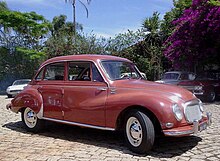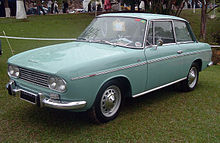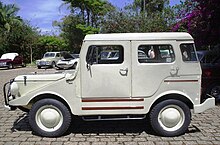Veículos e Máquinas Agrícolas
| Veículos e Máquinas Agrícolas SA | |
|---|---|
| legal form | Sociedade Anônima |
| founding | 1945 |
| resolution | 1967 |
| Reason for dissolution | Takeover by Volkswagen do Brasil |
| Seat | São Paulo , Brazil |
| Branch | Automobiles |
Veículos e Máquinas Agrícolas SA , or Vemag for short , was a Brazilian manufacturer of automobiles .
Company history
The company was founded in São Paulo in 1945 . First, vehicles from the Studebaker Corporation were assembled. From 1953, the company produced in collaboration with Indústria e Comércio SA Auto Union (short INA ) vehicles of Auto Union . After INA was dissolved in 1955, there was a license agreement with Auto Union. The brand name was DKW-Vemag . Production ended in 1967 when Volkswagen do Brasil took over the company.
Brand vehicles Malzoni and Puma were based on Vemag vehicles.
vehicles
The first model was the Camioneta from 1956 to 1958. The two-door station wagon corresponded to the DKW F 91 Universal . In 1958 this model was already called Vemaguet . Around 1500 vehicles were built.
In 1958 the Vemaguet station wagon followed , based on the DKW F 94 Universal . The vehicles were powered by a three - cylinder two-stroke engine with a displacement of 900 cm³ and an output of 40 hp . As early as 1959, a larger engine with a displacement of 1000 cc and 44 hp was used. The facelift in autumn 1963 led to the Vemaguet 1001 with front hinged doors. In 1965 it was renamed Vemaguet Rio . With the facelift at the end of 1966, the car now called Vemag 1967 had double headlights.
Between 1962 and 1964, the Caicara was a more simply equipped version of the 1958 Vemaguet , i.e. with the smaller engine. Of these, 1173 vehicles were built.
The Pracinha, the successor to the Caicara, was on the market from 1965 to 1967 and found 6,750 buyers.
The Belcar , which appeared in 1958 as a four-door sedan, was also based on the DKW F 94. Initially called the Grande Vemag 900 , it also received the larger engine in 1959. From the model upgrade in autumn 1963, it was called 1001 and from 1965 Belcar Rio . The facelift for the 1967 model year brought double headlights and the name Belcar 67 . A total of around 52,000 Belcar were made .
In 1961 there were plans for a larger model. Carrozzeria Fissore designed the body. The car was presented as a prototype in 1962 and went into production as the Fissore in June 1963 . It was a two-door notchback sedan . The three-cylinder engine with a capacity of 981 cm³ developed 50 hp or 60 SAE hp. In 1965 the rear and 1966 the front were revised. 2489 vehicles were built from this model.
A vehicle with all-wheel drive corresponding to the DKW Munga was available from 1958 to 1960 as Jipe , from 1959 to 1960 as Jipe 1000 and from 1960 to 1963 as Candango 4 . The Candango 2 with two-wheel drive was in the range from 1960 to 1963. About 7848 of these models were made.
literature
- Harald H. Linz, Halwart Schrader : The International Automobile Encyclopedia . United Soft Media Verlag, Munich 2008, ISBN 978-3-8032-9876-8 , chapter Vemag-DKW.
- George Nick Georgano (Editor-in-Chief): The Beaulieu Encyclopedia of the Automobile. Volume 1: A – F. Fitzroy Dearborn Publishers, Chicago 2001, ISBN 1-57958-293-1 , p. 442. (English)
- Ralf Friese: DKW type customer. Post-war vehicles and foreign license models. Delius Klasing Verlag, Bielefeld 2011, ISBN 978-3-7688-3366-0 , pp. 104–125.
Web links
- João F. Scharinger: Lexicar Brasil (Portuguese)
- d'Auto (Dutch)
- Allcarindex (English)
Individual evidence
- ↑ Harald H. Linz, Halwart Schrader : The International Automobile Encyclopedia . United Soft Media Verlag, Munich 2008, ISBN 978-3-8032-9876-8 , chapter Vemag-DKW.
- ^ A b George Nick Georgano (Editor-in-Chief): The Beaulieu Encyclopedia of the Automobile. Fitzroy Dearborn Publishers, Chicago 2001, ISBN 1-57958-293-1 , p. 442. (English)
- ↑ a b c d e f g h i j k l Ralf Friese: DKW Typenkunde. Post-war vehicles and foreign license models. Delius Klasing Verlag, Bielefeld 2011, ISBN 978-3-7688-3366-0 , pp. 104–125.




